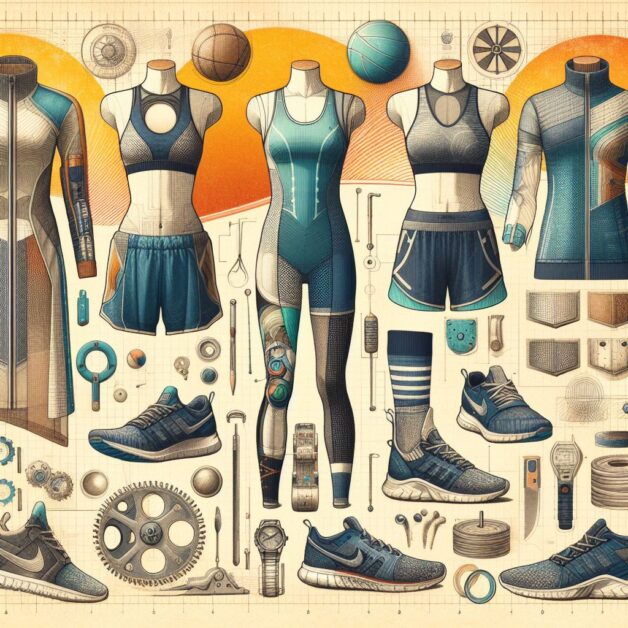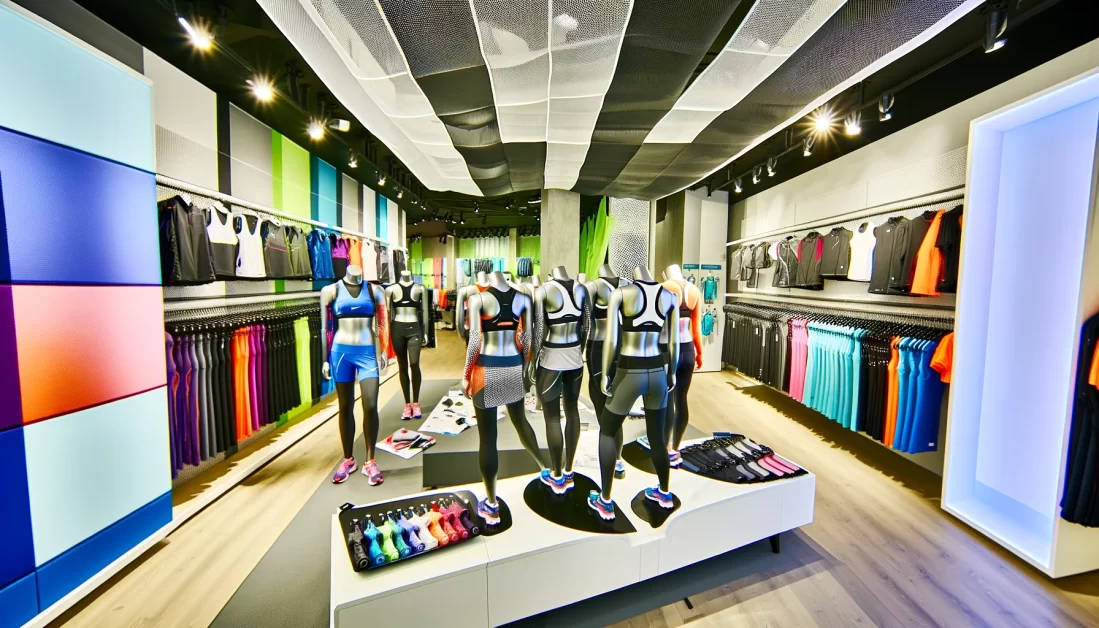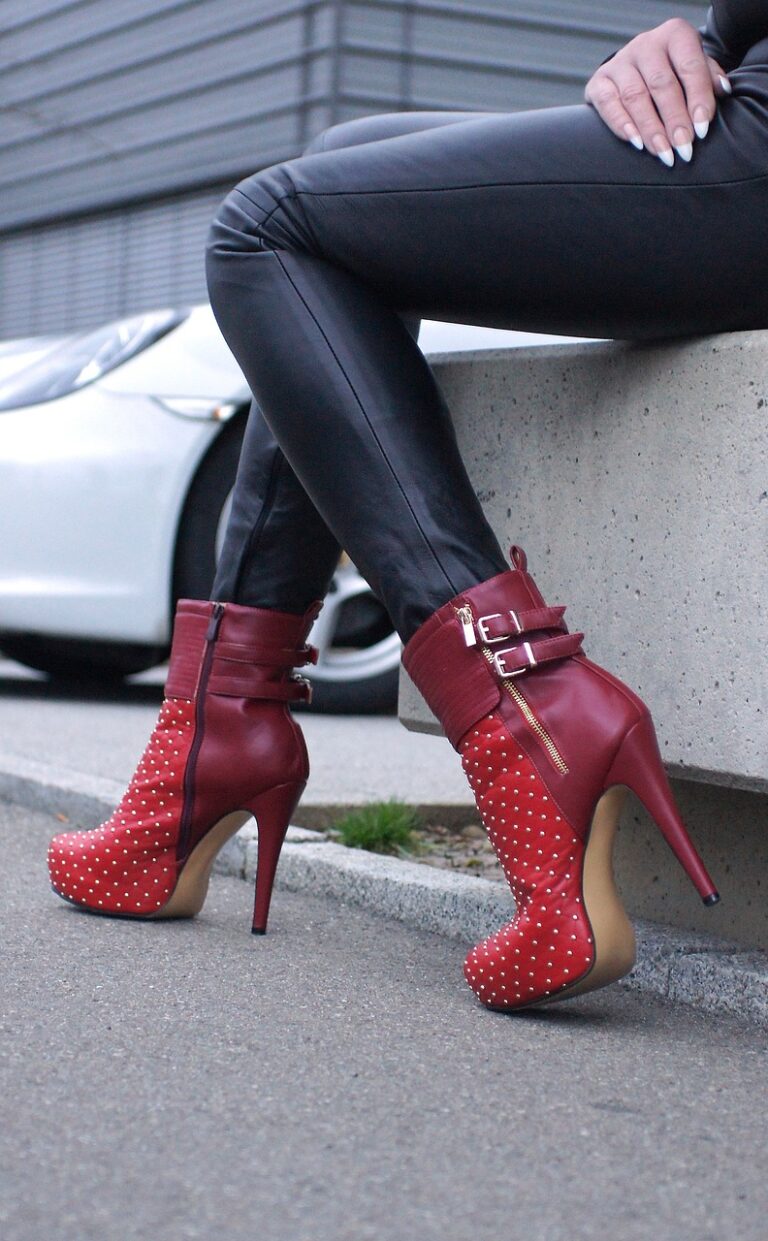Revolutionizing Performance: The Future of Sports Wear Materials and Designs
Discover how the latest innovations in sports wear materials and designs are revolutionizing performance. Explore cutting-edge technologies and trends shaping the future of athletic gear.
The Awesome Transformation of Sports Wear
Sportswear isn’t just about sweating it out anymore. It’s like a superhero suit, blending function and style to make you feel like a champion. Let’s dive into how materials and designs have supercharged the world of athletic gear.
Why Materials and Designs Matter
Materials are like the building blocks of sportswear. They decide how comfy your gear feels and how well it helps you perform. Thanks to intelligent fabric tech, we now have gear that keeps you cool when it’s hot, wicks away sweat, and even allows swimmers to glide through the water like dolphins. That’s some severe science working to make you unstoppable.

Designs are the cool factor. They’re not just about looks but about making your gear work with your body. Think ergonomic shapes that move with you, clever vents that keep things breezy, and strategic squeezes that help your muscles bounce back faster. It’s like your clothes are giving you a high-five for every move you make.
From Basic to Boss: The Evolution of Sports Wear
Back in the day, sports clothes were basic. They did the job, but they needed to turn heads. Then came the boom in pro sports and fitness fanatics, and suddenly, everyone wanted gear that was as serious about performance as they were. But it wasn’t just about winning races but also about feeling good and looking fly while doing it.
Nowadays, sportswear is like a high-tech fashion show. Whether you’re into yoga or hardcore CrossFit, the gear is tailor-made for you. And with more people caring about the planet, eco-friendly materials are all the rage. So, you can smash your goals and save the Earth simultaneously. Talk about a win-win!
Traditional Materials in Sports Wear
Cotton has been a staple in sportswear due to its natural origins, breathability, and softness, making it comfortable to wear during physical activities. However, its tendency to absorb moisture without quick drying can lead to discomfort and chafing during intense exercises or wet conditions.
This limitation highlighted the need for materials that could keep athletes dry and comfortable.
Polyester, a synthetic fabric, emerged as a popular alternative due to its durability, resistance to shrinking and stretching, and quick-drying properties. Its ability to wick moisture away from the body made it a preferred choice for a wide range of sports apparel.
Despite these advantages, Polyester’s synthetic nature raised concerns about environmental sustainability, as it is derived from petroleum and is not biodegradable.
Transition to Modern Materials
The shift towards modern materials in sportswear has been driven by two main factors: the quest for enhanced performance and a growing consciousness about environmental impact. Innovations in material science have led to the development of fabrics that meet the functional requirements of sports activities and align with sustainability goals.
Recycled Polyester represents a significant step towards sustainability, offering the same benefits as virgin Polyester (durability, moisture-wicking) while reducing the reliance on fossil fuels and minimizing waste. It’s made by recycling PET bottles, discarded polyester garments, and industrial polyester waste, presenting a more eco-friendly alternative that doesn’t compromise performance.
Advanced Natural and Synthetic Blends are also gaining prominence, combining the best of both worlds. Materials like bamboo fabric and Tencel (lyocell) are lauded for their sustainable credentials, moisture management, and softness.
Bamboo fabric, for instance, is made from the pulp of bamboo grass, offering natural antibacterial and moisture-wicking properties, while Tencel is celebrated for its environmental sustainability and exceptional comfort.
Innovative Fabrics, such as those with moisture-wicking capabilities, compression technology, and even integrated wearable technology, are setting new standards for performance and comfort. For more reading about technical clothing.
These materials enhance the athlete’s experience by improving moisture management, offering muscle support, and enabling intelligent health tracking.

Innovative Materials in Sports Wear
Eco-Friendly Fabrics
- Recycled Polyester
- Benefits: Nearly identical in quality to virgin Polyester but uses less water and energy for production. Helps reduce plastic waste by repurposing PET bottles and old garments.
- Impact on Sustainability: Significantly lowers carbon footprint. Promotes a circular economy by turning waste into wearable fabrics.
- Tencel and Bamboo Fibers
- Advantages in Comfort: Both are exceptionally soft, breathable, and moisture-wicking, offering superior comfort for various activities.
- Environmental Impact: Tencel is produced from sustainably sourced wood pulp in a closed-loop process, minimizing waste and water use. Bamboo proliferates with little water and without pesticides, making it a highly renewable resource.
Advanced Performance Materials
- Moisture-Wicking Fabrics
- Enhance Athlete Performance: By quickly moving sweat away from the body to the fabric’s surface where it can evaporate, these fabrics keep athletes dry and comfortable, reducing friction and the potential for chafing.
- Examples: Polyester blends, microfiber, and engineered mesh fabrics.
- Compression Materials
- Benefits for Muscle Recovery: Improve blood circulation and oxygen delivery to muscle groups, speeding up recovery times and reducing muscle fatigue during and after exercise.
- Performance Enhancement: Support muscles, improving performance and reducing the risk of injury by stabilizing muscles and reducing vibration.
Design Evolution in Sports Wear
Ergonomic Designs
- Importance for Athlete Comfort: Tailored to fit the body’s natural movements, reducing restriction and enhancing flexibility. Offers targeted ventilation and support where needed most.
- Performance Enhancement: Maximizes efficiency by reducing drag, minimizing muscle oscillation, and optimizing thermal comfort. Key in preventing injuries and prolonging endurance.
Integration of Technology
- Intelligent Fabrics: Embedded with sensors to monitor health metrics like heart rate, temperature, and even hydration levels. Enables real-time performance tracking and feedback.
- Wearable Tech in Apparel: Incorporates GPS, biometric monitoring, and smartphone connectivity for data analysis and personalized coaching advice. Revolutionizes training by making it more data-driven.
For more insights into the global smart clothing and fabrics market, check out the following resources: Statista’s analysis of smart clothing and fabrics shipments worldwide
Aesthetic Trends
- Balancing Style and Functionality: Designs reflect current fashion trends while retaining performance features. Offers athletes choices that express personal style without compromising on functionality.
- Inclusivity and Customization: Expands to cater to diverse body types and preferences. Includes options for adaptive sportswear, ensuring accessibility for all athletes.
Sustainable Practices in Sports Wear Production
Overview of Sustainable Manufacturing Processes
- Reduced Water Usage: Implementing water-efficient dyeing and finishing processes to minimize water consumption.
- Energy Efficiency: Utilizing renewable energy sources, like solar and wind power, in production facilities to lower carbon emissions.
- Waste Reduction: Adopting zero-waste initiatives, such as recycling cut-offs and using leftover materials to create new products.
- Eco-friendly Materials: Prioritizing sustainable fabrics that are either recycled or derived from renewable resources with lower environmental footprints.
- Chemical Management: Employing non-toxic dyes and treatments to ensure the safety of the environment and the workers.
The Role of Consumer Choices in Promoting Eco-Friendly Sports Wear
- Demand for Transparency: Encouraging brands to disclose their manufacturing processes and sustainability practices, fostering a culture of accountability.
- Supporting Sustainable Brands: OptOpt for brands that prioritize eco-friendly materials and production methods, incentivizing more companies to adopt sustainable practices.
- Longevity Over Fast Fashion: Preferring quality and durability to reduce the cycle of consumption and waste, promoting a more sustainable approach to sportswear.
- Recycling and Upcycling: Participating in programs that allow for the recycling or repurposing of sportswear, minimizing waste, and extending the lifecycle of products.
- Educating and Advocating: Spreading awareness about the importance of sustainable practices in sportswear production and making informed choices that contribute to a healthier planet.
The Future of Sports Wear
Predictions on Material and Design Innovations
- Bio-based Materials: Increased use of materials derived from natural, renewable sources that offer enhanced performance and lower environmental impact.
- Smart Textiles Evolution: Fabrics that can adapt to environmental conditions, such as temperature-regulating materials, and those that change color based on UV exposure or body heat.
- Customization and Personalization: Advances in 3D printing and scanning technologies enable bespoke sportswear that fits individual body shapes perfectly, enhancing performance and comfort.
Potential Impact of Emerging Technologies
- AI in Design and Manufacturing: Artificial Intelligence (AI) will revolutionize design by predicting trends and optimizing fit and performance based on vast datasets of wearer feedback. AI can streamline production, reduce waste, and improve quality control in manufacturing.
- Nanotechnology in Fabrics: Incorporating nanotechnology into sportswear fabrics could lead to garments with unprecedented capabilities, such as self-cleaning, water-repellency, enhanced durability, and even health monitoring at the molecular level.
Smart Textiles Sense How Their Users Are Moving
- MIT Media Lab researchers have developed a novel fabrication process for smart textiles that fit snugly on the user’s body.
- These textiles provide precise pressure sensor data, which can be used to analyze and classify the wearer’s postures and motions.
- Read about it
Final Thoughts:
The journey of sports wear, highlighted by advancements in materials, designs, and sustainable practices, showcases the significant progress we’ve made towards creating apparel that enhances athletic performance and prioritizes environmental responsibility. Dart Sports Pro stands at the forefront of this evolution, committed to integrating the latest in eco-friendly materials and cutting-edge design innovations to offer athletes high-performing and sustainable apparel.
Dart Sports Pro is your ultimate guide to dartboard & sports, with reviews, tips, news, and more on Sports Gear and other topics.
As Dart Sports Pro continues to pioneer in this space, we encourage our consumers to join us. By choosing sportswear that aligns with your performance needs and sustainability values, you contribute to a movement that values our planet as much as athletic achievement.
What are your thoughts on the future of sportswear? How do you see innovations in materials and technology shaping your athletic wear choices? Let’s discuss how we can all play a part in the sustainable evolution of sports apparel.





